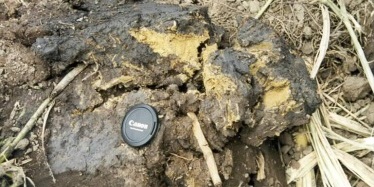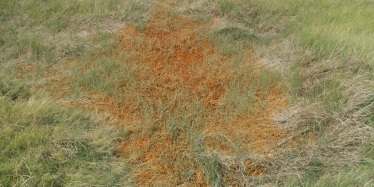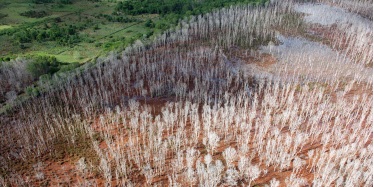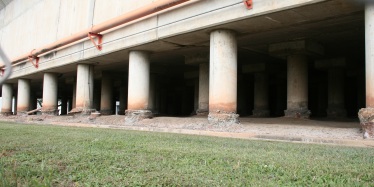Identifying acid sulfate soils
The accurate and early identification of acid sulfate soils is important when developing strategies to manage them.
Two main terms are used when identifying acid sulfate soils:
- potential acid sulfate soils (PASS)
- actual acid sulfate soils (AASS).
Potential acid sulfate soils are soils containing iron sulfides (commonly pyrite) which have the potential to produce sulfuric acid if they are drained or excavated.
Actual acid sulfate soils have already undergone oxidation to produce acid, resulting in a soil pH of less than 4. They also often exhibit yellow and/or red mottling in the soil profile. If these soils still contain sulfides, they have the potential to produce more acid.
Indicators of acid sulfate soils include:
- soil physical features
- soil chemical features
- signs in the environment
- vegetation
- infrastructure effects
Note
This information provides basic understanding about acid sulfate soils. If you are looking for information on how to conduct a site investigation and risk assessment that will support an acid sulfate soils management plan, please view the applicable guidance materials for acid sulfate soils.
Physical features
Undisturbed soils
Undisturbed acid sulfate soils look quite distinctive. They are always wet, usually entirely saturated, and may not be easy to walk on.
Their anaerobic state gives them a steely blue-grey colour (or ‘gley’), which can range from pale to dark shades. They can even be greenish in some cases.
Marine sediments will often contain seashells and similar carbonate materials such as crab shells.
Organic materials may be present, particularly the remnants of plants and grasses. If the soil has been consistently anaerobic, they may be well-preserved.
A strong smell of rotten eggs may come from the soil—this is hydrogen sulfide (H2S) gas, produced by the breakdown of sulfur and organic materials.
Prolonged exposure to high levels of this gas is life-threatening. Caution is needed when working in soil pits and confined spaces (e.g. during marine construction works) as the gas is heavier than air and can accumulate fast.
Oxidised soils
Oxidised acid sulfate soils can be quite dry, with strong blocky structure.
The ‘gley’ colours disappear, to be replaced by dark to pale browns.
Oxidised acid sulfate soils will often contain yellow and orange mottling. The yellow mottle is the mineral jarosite and the orange colours are other iron oxide minerals.

The thickness of this mottled layer, its degree of development, the soil moisture and the field test results will help distinguish the actual acid sulfate soils. Potential acid sulfate soils may be present under an actual acid sulfate soil layer. The top of the potential acid sulfate soil layer may also be seasonally oxidised due to water table movement.

Chemical features
While the physical features of acid sulfate soils are useful, chemical tests of soil pH are the key criteria to identify an acid sulfate soil.
This criteria is based on the difference between 2 main pH tests:
- field pH (pHF)—pH in deionised water
- field oxidised pH (pHFOX)—pH in 30% hydrogen peroxide.
Interpreting pH tests
When interpreting field pH (pHF) results, the following results are a general guide.
pHF value | Description |
|---|---|
<4 | Oxidised acid sulfate soil (extremely acidic)—jarosite may be present |
<4.5 | Extremely acidic, most likely due to pyrite oxidation—but can be due to the soil being highly organic, or from prolonged fertiliser use |
4.5–5.5 | Very acidic soil, however it is not conclusive that low pH is due to pyrite oxidation |
6–7 | No actual acidity—common in undisturbed acid sulfate soil. Marine-influenced samples can have pHF up to ~8 |
The pHF test does not detect acidity bound up in unoxidised sulfides, so the pHFOX test is conducted as well. Rapid reaction with concentrated peroxide fast-forwards the oxidation of pyrite and provides an indication of the potential acidity that could be released from the soil.
When interpreting field oxidised (pHFOX) results, the following is a general guide.
pHFOX value | Description |
|---|---|
<3 | Strongly indicates acid sulfate soils |
3–4 | Possibly acid sulfate soil, but less certain—lab analysis would be required to confirm presence of sulfides |
4–5 | Possible small amount of sulfides present, or the sample might be poorly reactive or fine carbonates are present. Laboratory analysis will again be necessary to determine the soil’s status. |
>5 | With a minimal difference to pHF, this is unlikely to be acid sulfate soil unless fine carbonates are present in the sample |
Examples
A typical unoxidised acid sulfate soil may have results of pHF ~6.5 and pHFOX ~2. The sample will usually react explosively to the peroxide.
A typical oxidised acid sulfate soil may have results of pHF ~3.5 and pHFOX ~1. The reaction to peroxide is more variable.
Field pH tests cannot be used to estimate how much pyrite is in the soil—they are a presence/absence test only. A full suite of laboratory analyses run in compliance with the laboratory methods guidelines or Australian Standard 4969 are required to determine the amount of pyrite in soils.
Signs in the environment
Water
Oxidising acid sulfate soils will affect the water quality of surface and ground waters. Acidity and iron are the main contaminants.
The acidity generated in the soil also attacks soil minerals, releasing aluminium. High aluminium and low pH levels combine to flocculate soil particles suspended in water, and these sink to the bottom. As a result, acid-affected water can be extremely clear and blue-green in colour.
Reduced iron (Fe2+) released from acid sulfate soils will oxidise in waters and fall onto banks and vegetation as an orange scum. An oily film of iron-loving bacteria can form on the surface of slow-moving or still water. It can be differentiated from a petrochemical film because when it is disturbed the film fragments do not reform.
Vegetation
Vegetation can also be affected by acid and metals. Severely acid ground may be entirely bare, and areas of dead or dying vegetation are a distinct warning sign. However, these problems may also be related to issues like waterlogging, salinity and nutrient deficiencies, particularly in crops like sugarcane. The source of vegetation changes need to be accurately identified.
Soils
When acid sulfate soils dry they can change. The soils will shrink irreversibly and unevenly in the absence of water, often cracking at the surface. Soils can sink or collapse significantly and can cause permanent changes in local hydrology. Poorly-managed construction can also trigger sinking problems—saturated soils can only bear light loads and heavy weights can compress them.

Vegetation indicators
Three classes of vegetation can help identify acid sulfate soils or can indicate that acidification may have already taken place:
- acid-tolerant—direct relationship with acid environments
- salt-tolerant—common to areas like estuaries and swamps where acid sulfate soils form
- waterlogging—common also to areas like swamps where acid sulfate soils form.
Some common vegetation which falls into 1 or more of these 3 groups include:
- Mangrove species—this group includes related species like mangrove ferns. They all thrive in anaerobic soils and saline waters. These plants are a key source of organic matter aiding acid sulfate soil formation in coastal wetlands.
- Marine couch (sporobolus virginicus)—also known as salt couch or saltgrass—this is a coastal tussock grass common to salt flats and estuaries as well as beach dunes. This is mainly a salt-tolerant species, but it is also significant in that it tends to grow on key acid sulfate soil landforms.
- Melaleuca species (or ti-trees)—commonly known as paperbarks—commonly found at the fringe of wetlands, behind the mangrove and salt flat environments and edging watercourses. They are tolerant of salt and of periodic/temporary waterlogging.
- Casuarina and allocasuarina species (or she-oaks)—similar in distribution and tolerances to melaleuca species and commonly found growing near brackish water.
- Phragmites australis—this tall tussock grass species is tolerant of acidic and waterlogged conditions. It is very common in areas where some oxidation of acid sulfate soil has occurred, whether through natural seasonal processes or human activity.
- Water lilies—may appear in surface of water with relatively low pH. They are only notable when the species has crowded out other aquatic plants. Its acid-tolerance lends it a competitive advantage in waters affected by acid sulfate soils. Testing the pH of waters where lilies are thriving is advised.

Infrastructure effects
Many of the indicators described above can be obscured by development—landforms rearranged by earthworks, vegetation removed, watercourses re-rerouted or eliminated.
Some indicators will remain useful, and new ones will appear. Vegetation growth problems, iron staining, clear waters and fish kills still remain possible indicators, although other possible causes will need to be eliminated.
Acidity in water and soil will attack concrete and steel structures. With concrete, corrosion can be rapid as the carbonates in the concrete matrix are consumed. This is often easily visible on canal walls, at the base of bridges and in road culverts.
Damage to underground structures like water mains and foundations are much harder to detect before structural failure occurs. Concrete failure can still be caused by other factors, such as poor ingredients and improper mixing, and this possibility should be investigated.
Asphalt surfaces are also affected and may blister and crack. Jarosite crystals may form around areas of blistering. Subsidence may occur, damaging roads and foundations.


